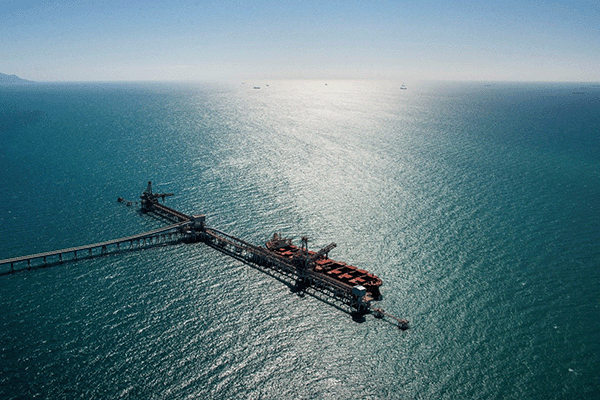Master planning for the priority Port of Abbot Point

Photo courtesy of North Queensland Bulk Ports.
The Queensland Government is leading master planning for the priority Port of Abbot Point in accordance with the Sustainable Ports Development Act 2015 and the Reef 2050 Long-Term Sustainability Plan.
About the port
The priority Port of Abbot Point is located 25km north of Bowen, between the regional centres of Townsville and Mackay.
The Port of Abbot Point is Australia's most northern coal export port. The location of the port is strategically significant as it is situated away from urban development and one of the few places along Australia's eastern coast where naturally deep water is close to shore. The proximity of the port to the Bowen and Galilee Basin and major road and rail transport corridors mean it is well positioned for future growth.
Read more about the priority Port of Abbot Point.
Master plan
The Master plan for the priority Port of Abbot Point is a strategic document that has a long-term outlook for the sustainable development of the port through to 2050. Long-term master planning provides a strategic and coordinated approach to managing port-related development and considers issues including marine and land-based impacts, port development and supply chain infrastructure optimisation.
The master plan looks beyond the port boundary to ensure port-related development is sustainably managed while protecting the Great Barrier Reef.
The master plan recognises the potential of the priority Port of Abbot Point to be a major contributor to Queensland’s green energy production, including renewable hydrogen. The master plan seeks to support existing port operations, and also provides the framework for encouraging new trades and industries to promote sustainable port development, and support trade diversification as a pathway to net zero emissions by 2050.
The master plan also includes areas identified for environmental protection, including the Caley Valley Wetlands and areas of significance to the Juru people. The Caley Valley Wetlands is a nationally important wetland and habitat for large numbers of threatened migratory birds and shorebirds. It also contains a diverse range of habitat for many plant and animal species, coastal open waters, mangrove forests, marsh areas, lakes and streams.
Master planned area
The priority Port of Abbot Point master plan includes a master planned area which encompasses a total area of about 21,500 hectares, 18,000 hectares of land and 3,500 hectares of marine area.
The master planned area includes land and marine areas required for the efficient development and operation of the port. The inclusion of land and marine areas supports the management of potential impacts on the Outstanding Universal Value of the Great Barrier Reef World Heritage Area and other environmental values that may occur as a result of port development and operations.
The master planned area includes:
- strategic port land under the Transport Infrastructure Act 1994, managed through the Land Use Plan for Port of Abbot Point
- the Abbot Point State Development Area under the State Development and Public Works Organisation Act 1971
- land within the Whitsunday Regional Council local government area
- marine areas within port limits but outside State and Commonwealth marine parks.
Four precincts within the master planned area outline the long-term intent for specific areas. The individual precinct approach supports cumulative impact management within the master planned area by identifying areas with environmental values where development should be limited, and separate areas that may be suitable for infrastructure and port-related development.
A single priority management measure has been included for the Port of Abbot Point which will apply to all 4 precincts. This measure requires for the preparation and implementation of a coordinated management strategy which will integrate economic, environmental and cultural values to protect and enhance the Caley Valley Wetlands.
Port overlay
The Port Overlay for the priority Port of Abbot Point is planned for release in early 2024.
How the master plan was developed
Master planning for the priority Port of Abbot Point was a collaborative process undertaken with the North Queensland Bulk Ports Corporation Limited, Whitsunday Regional Council, state and federal agencies, and other key stakeholders in accordance with the Ports Act.
We made the Master plan for the priority Port of Abbot Point on 21 November 2023. This followed the release of the Draft master plan for the priority Port of Abbot Point for public consultation from 17 October 2022 to 20 January 2023.
During the same consultation period we released the Draft Port overlay for the priority Port of Abbot Point for public consultation.
Public consultation for the draft master plan provided the community and industry with the opportunity to have their say on the sustainable growth of the port. Submissions received during the public consultation periods for the draft master plan informed the final master plan.
Further information about the approach to preparing master plans and how these operate can be found in the Priority ports master planning guideline.
Community consultation
From 17 October 2022 to 20 January 2023 we asked the community to have their say on the port master planning process.
Over the 14 week consultation period we:
- held 2 community information sessions
- set up a dedicated phone number to answer any questions throughout the consultation period
- made hard copies of the draft master plan and draft port overlay available at 2 locations.
We received a total of 8 submissions addressing the priority Port of Abbot Point draft master planning documents. The community provided valuable insights during the consultation process that have been considered when finalising the draft master plan.
More information
- Last updated 29 November 2023

